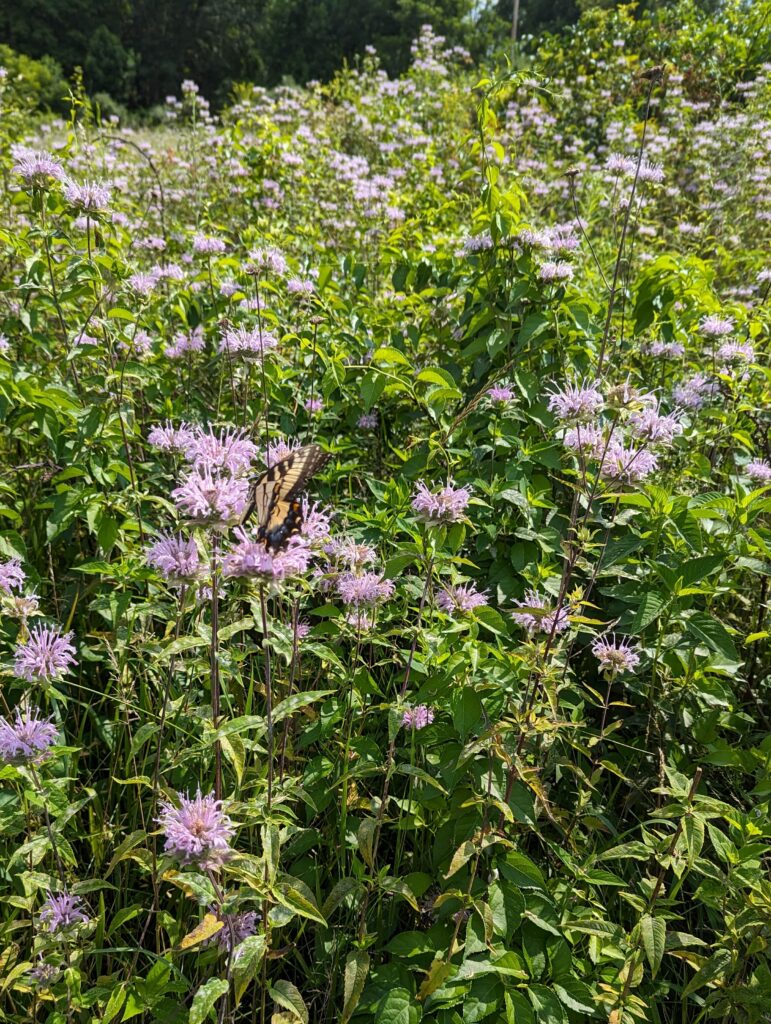 Last week I saw a field of wild bergamot or Monarda fistulosa in full bloom. This miracle of nature, which may or may not have been helped along by human beings, was a sea of pale purple. Butterflies—monarchs, sulphurs, swallowtails and red admirals—danced just above the blooms, landing long enough to sip nectar. The buzzing was almost audible as hundreds of bees worked the flowers. The field, which was in a state park, was a living Impressionist painting.
Last week I saw a field of wild bergamot or Monarda fistulosa in full bloom. This miracle of nature, which may or may not have been helped along by human beings, was a sea of pale purple. Butterflies—monarchs, sulphurs, swallowtails and red admirals—danced just above the blooms, landing long enough to sip nectar. The buzzing was almost audible as hundreds of bees worked the flowers. The field, which was in a state park, was a living Impressionist painting.
The sight made me wild about bergamot.
Monarda fistulosa and its relative, Monarda didyma, are both native to North America and have been used for medicinal and decorative purposes. The plants are part of the mint or Lamiaceae family, something you can see if you look at a cross section of a stem, which is square. The plants grow two to four feet tall and can be up to three feet wide, forming clumps if left to their own devices. Toothed leaves dominate the stalks and grow opposite each other in characteristic mint fashion. High atop each stem are the flowers, which look a little chaotic or shaggy from a distance. Up close, you can see that each “flower” is made up of a whorled array of small, tubular blooms, similar to many others in the mint family, and perfect for butterfly probosces or hummingbird bills. Monarda fistulosa features lavender blooms, while Monarda didyma in its natural state boasts red ones. All the plant parts are aromatic, and the leaves can be dried and made into tea, giving rise to one of the genus nicknames, “Oswego tea”. The “Oswego” designation is from the indigenous tribe that made medicinal use of the plants.
“Wild bergamot”, another common name, refers to the plant’s fragrance, which is similar to bergamot, a citrus fruit best known as the primary flavoring ingredient in Earl Grey tea.
As most gardeners know, mints in general are tough and vigorous, sometimes to the point of invasiveness. Monardas are not always invasive, but they are certainly hardy, capable of withstanding clay soil, impervious to the toxins secreted by black walnut roots, and unappealing to four-legged predators like deer and rabbits. This is why they have been garden favorites, probably since the first colonists saw them in the wild and uprooted clumps for own plots. Their fame spread across the ocean, to the point that English herbalist Maude Grieve, included Monarda didyma in her 1931 work, A Modern Herbal, noting, “This species, on account of its aromatic odour, has become a favourite in our gardens.”
It has also become a favorite of plant breeders, who have worked to make flowers larger, stems shorter and color ranges wider. The colors, which run through a range of pinks, reds and purples, tend towards the dramatic, with descriptors like “electric”, “neon” and “rockin’” making appearances in varietal names. Many of the current retail offerings are hybrids. For color pops, try varieties like ‘Purple Rooster’, bright purple with a suggestion of magenta, or ‘Cherry Pops’, with eye-catching red blooms accented by dark foliage.
If shorter monardas fit better into your planting schemes or containers, the bright purple ‘Grape Gumball’, at about two feet tall, may work perfectly. ‘Lilac Lollipop’ is similarly short and just slightly less bright. Another shorter variety, ‘Pink Chenille’ features bright pink flowerheads.
Monarda is easy to obtain and easy to care for. Unfussy about soil, it does benefit from consistent moisture, especially as it establishes roots as young plant. Once established, the plants have a tendency to spread. This is valuable if you are trying to fill space, but will require a bit of vigilance if you are attempting to maintain a balanced garden display. Fortunately, unwanted plants are not hard to remove.
Nothing in life is perfect, and monarda is no exception. Older varieties are very susceptible to powdery mildew, a fungal disease that affects the foliage, but will not kill the plants. Newer hybrids have been bred to be mildew resistant, so most varieties available in garden centers and through online retailers will be less prone to the affliction. Good air circulation between clumps will also help keep mildew at bay.
Monarda is stunning in gardens and containers, but also works well in cut flower arrangements. If you have a domestic cat, the animal may be drawn to the minty smell and inclined to either chew leaves or pull the flowers out of the vase. Fortunately the leaves and flowers should not be toxic and most cat owners are prepared for their pets’ forays into floristry.
Monardas are on plant pallets now at retailers everywhere, but can also be obtained from online vendors. For a good selection try Bluestone Perennials, 7211 Middle Ridge Rd., Madison, OH 44057; (800) 852-5243; www.bluestoneperennials.com. Print catalog available.
